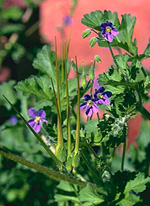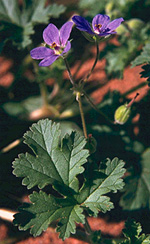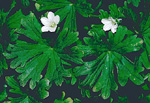 |
This is a cosmopolitan family with 3 genera native or naturalised in temperate southern Australia, in open or shady areas from coastal dunes to the high alps, with a few penetrating the arid interior especially on heavy soils.
Characteristic features of the family Geraniaceae in Australia include: - herbs (sometimes soft-wooded shrubs) with mostly opposite, often pinnately or palmately lobed or veined leaves, usually with prominent, interpetiolar stipules.
- flowers with 5 free sepals and petals (the latter usually white, pink or blue) and 4, 5 or 10 stamens which are free but closely grouped in the centre of the flower
- ovary superior, 5-loculed, with a terminal style that persists on the fruit and grows into a characteristic beak-like awn
- fruit either splitting from the base into 5 valves, each with a single seed and part of the awn, these either curving back explosively to throw the seed away (Geranium), or separating completely with a curved or twisted portion of awn and dispersed by wind, birds or animals (Erodium, Pelargonium)
Description
Evergreen shrubs, or annual or perennial terrestrial herbs. Perennating by taproots or crowns. Vegetative reproduction absent or by stolons. Internal secretions not obvious. Plants with simple, glandular or non-glandular, unicellular or uniseriate hairs. Leaves alternate and spiral, both basal and cauline if herbs, petiolate or peltate. Stipules distinct and free from the petiole, green and leafy, persistent; stipellae absent. Lamina simple or once compound, imparipinnate, rarely ternate or palmate, symmetric, pinnatifid or pinnatisect or palmatifid or rarely palmatisect; lamina/leaflets lanceolate, ovate, elliptic, oblong, orbicular or reniform; base rounded or cordate; margins entire, crenate, dentate or serrate, ±flat; venation pinnate, with the midrib conspicuous, and the tertiary venation reticulate; surfaces not punctate; herbaceous; distinctive odour absent or aromatic. Plants with all the flowers bisexual. Inflorescences terminal or leaf opposed, consisting of monochasial cymes, umbels or solitary flowers. Bracts and bracteoles present. Pollination by insects. Flowers odourless or fragrant; stalked. Floral disc present; nectaries absent, or present on the disc. Perianth of 2 dissimilar whorls, imbricate in bud. Calyx regular; segments free, with 5 sepals, herbaceous; base with spurs or pouches or without appendages. Corolla regular or irregular; segments free, with 5 petals, alternating with the sepals; corolla 2-lipped, with or without palate, white, pink, magenta, purple, violet or blue, without contrasting markings, or streaked, spotted, etc, membranous; claws present or absent; lobes ±entire or notched, emarginate, bifid or bilobed. Fertile stamens 4–5 or 10, both opposite to and alternating with the sepals, free of the corolla, free of the ovary and style, distinct from each other, all ±equal or distinctly alternating long and short. Staminodes present or absent. Anthers dorsifixed, versatile, opening outwards or inwards by longitudinal slits, 2-celled. Ovary superior and sessile. Carpels 5, fused; ovary with 5 locules. Style terminal, single and branched above. Ovules 1–2 per locule, stalked; placentation axile. Fruit a dry schizocarp forming mericarps, with dehiscence sometimes explosive; the perianth on the maturing fruit deciduous, dry and persistent or growing larger. Disseminule macro-surface featureless or awned; micro-surface ±reticulate, brown, grey or black, dull. Seeds 5 per fruit. Aril absent. Cotyledons 2. Embryo straight, curved or sharply bent.
(Note: this description has been generated from the coded data compiled for the key. Any errors in the key data will be reflected in the descriptions.)
A treatment of the family Geraniaceae has not yet been published in the Flora of Australia. It will appear in Volume 27.
Australian genera of Geraniaceae (as recognised for the Flora of Australia)
† = some species native, others introduced
†Erodium
†Geranium
†Pelargonium

|
  |

Erodium crinitum (flowers and fruit)
Photo: D.Jones © D.Jones

Erodium crinitum (flowers)
Photo: A.S.George © A.S.George

Geranium antrorsum (dehisced fruits)
Photo: C.Totterdell © ANBG

Geranium potentilloides (flowers)
Photo: C.Totterdell © ANBG

|

| |